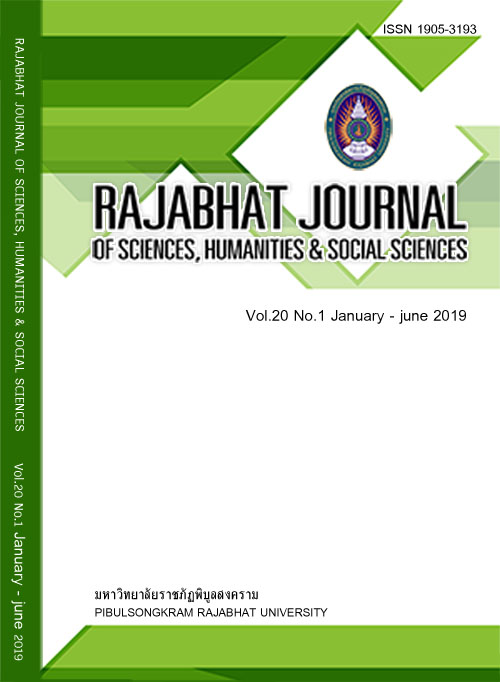THE GENDER ISSUES AND IDENTITIES OF THE YOUNG TOMBOY AND LESBIAN IN CHIANG MAI AND PHITSANULOK OF THAILAND
Keywords:
tomboy, lesbian, identity, genderAbstract
This article aims to study the gender identities of young tomboy/transman and lesbian in Chiang Mai University, Chiang Mai province, and Pibulsongkram Rajabhat University, Phitsanulok province of Thailand. It also aims to reflect the gender issues of LGBTI people in Thai society, particularly in educational institutions. The research method employed the qualitative research method with the in-depth interview and focus group with the undergraduate students. It was found that the expression of gender identities and sexualities of young tomboys and lesbians is mostly related to family acceptance. Even though the young tomboys and lesbians are freely open themselves and their identities are more accepted in Thai society, but it still has the hidden problem on gender issues behind this open environment. These include a gender discrimination, a social pressure and a family expectation in heterosexual aspects, and sexual harassment in schools and workplaces. In particular, verbal sexual harassment is still an important problem for the actual acceptance in the gender diversity of Thai society. Therefore, gender issues on discrimination and sexual violence could happen at the same time in several social communities such as schools, families, and workplaces. This situation importantly reflects the lack of understanding and education on the gender diversity of Thai schools and society.
References
Burapha University and UNDP. A Tool for Change: Working with the Media on Issues Relating to Sexual Orientation, Gender Identity, Expression and Sex Characteristics in Thailand, 2017. Available at: https://www.th.undp.org/content/thailand/en/home/presscenter/articles/2017/ 07/19/a-tool-for-hange1/. Accessed December 2, 2018.
International Labour Organization. Gender Identity and Sexual Orientation in Thailand, 2014. Available at: https://www.ilo.org/wcmsp5/groups/public/---asia/---ro-bangkok/---srobangkok/ documents/publication/wcms_356950.pdf. Accessed December 2, 2018.
Jackson A. & Sullivan G. (Eds.). Lady Boys, Tom Boys, Rent Boys: Male and Female Homosexualities in Contemporary Thailand. New York: Harrington Park Press; 1999.
Poteat VP. & Scheer JR. GSA advisors’ self-efficacy related to LGBT youth of color and transgender youth, Journal of LGBT Youth. 2016; 13(4): 311-325.
San Francisco State University. Family Acceptance of Lesbian, Gay, Bisexual and Transgender Youth Protects Against Depression, Substance Abuse, Suicide, study Suggests, 2010. Available at: www.sciencedaily.com/releases/2010/12/101206093701.htm. Accessed November 4, 2018.
Sexuality Resource Center for Parents. A Definition of Sexuality, 2018. Available at: https://www.srcp. org/for_all_parents/definition.html. Accessed December 20, 2018.
Sim A. Sapphic Shadows: Sworn Sisterhoods and Cyber Lesbian Communities in Hong Kong. In Kuah-Pearce K. (Eds.), Chinese Women and the Cyberspace, 2008. Amsterdam: Amsterdam University Press; 181-202.
Sinnott M. Masculinity and Tom Identity in Thailand, Journal of Gay & Lesbian Social Services. 1999; 9 (2-3): 97-119.
Spargo T. Foucault and Queer Theory. U.K.: Icon Books Ltd.; 1999.
Tangmunkongvorakul A, Banwell C, Carmichael G. et al. Sexual identities and lifestyles among non-heterosexual urban Chiang Mai adolescents: implications for health, Cult Health Sex. 2010; 12(7): 827-841.
UNDP, USAID. Being LGBT in Asia: Thailand Country Report. Bangkok: UNDP Asia-Pacific Regional Centre; 2014.
UNDP. Being LGBT in Thailand: A National Survey on Experiences and Social Attitudes towards Sexual Orientation, Gender Identity and Gender Expression (Final Draft Report). Bangkok: United Nations Development Programme UNDP Asia-Pacific Regional Centre; 2018.
Vanderbilt University. Lesbian, Gay, Bisexual, Transgender, Queer, & Intersex Life, 2018. Available at: https://www.vanderbilt.edu/lgbtqi/resources/definitions. Accessed December 3, 2018.
Wei C. & Liu W. Coming out in Mainland China: A national survey of LGBTQ students, Journal of LGBT Youth. 2017; 16(2): 192-219.
Women’s Rights and Economic Change. Intersectionality: A Tool for Gender and Economic Justice, 2004. Available at: https://lgbtq.unc.edu/sites/lgbtq.unc.edu/files/documents/intersectionality _en.pdf. Accessed November 4, 2018.
Downloads
Published
How to Cite
Issue
Section
License
Each article is copyrighted © by its author(s) and is published under license from the author(s).










